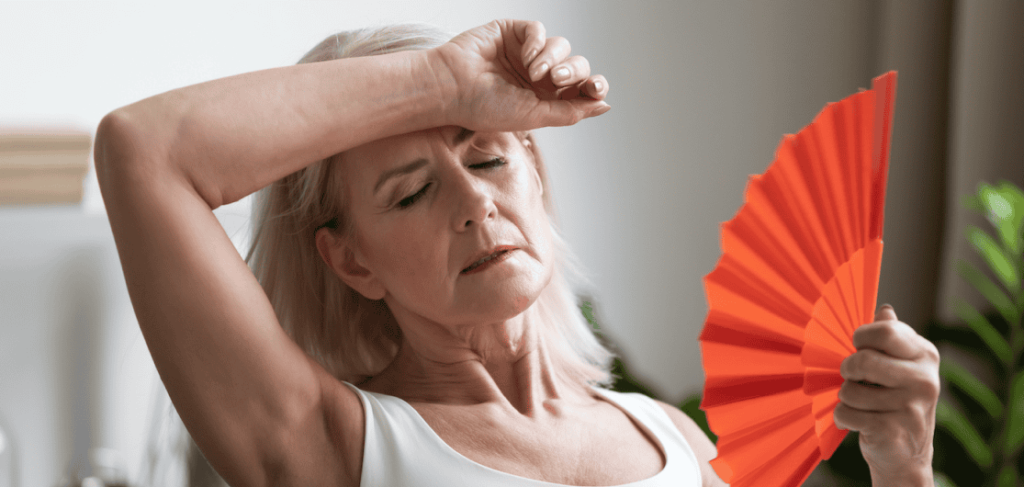Menopause & HRT
What is Menopause?
The deficiency of hormones produced by the ovary is the main cause of the symptoms of menopause.
You will be classed as postmenopausal when it has been one year since your last menstrual period. While there is a wide variation in the age of onset of menopausal symptoms, the average age of onset is between 45 and 55 years of age. The average age of menopause in the UK is around 51 years.
Benefits of Menopause care
How do I know if I am menopausal?

Commonly reported symptoms of menopause include:
- Hot flushes: These are feelings of sudden onset intense warmth in your face, neck and chest that can last for 1-5 minutes.
- Night sweats: You might wake up in the middle of the night with profound sweating.
- Sleep disturbances: Menopause can cause severe disruption of your sleep cycle.
- Vaginal dryness, itchiness, burning sensation: The lack of hormones can cause a reduction in vaginal moisture and lubrication, leading to discomfort during intercourse or painful sex.
- Urinary symptoms like increased frequency, urgency and urine leakage.
- Mood changes: Menopause is associated with many variations in moods, ranging from anxiety and mood swings to depression.
- Low libido or reduced desire to have sex.
- Joint aches, muscle aches, dryness of skin, hair.
- Weight redistribution around the tummy: The lack of hormones can cause a redistribution of body fat, adding inches around your belly.
Frequently Asked Questions (FAQs)
If you get the symptoms of menopause, like hot flushes and night sweats, but still have periods you are probably perimenopausal. Blood tests are usually not reliable to diagnose menopause at this stage due to fluctuating hormone levels. If you are above the age of 45 and have the symptoms of menopause you can be started on menopausal hormone therapy, typically known as HRT or Hormone Replacement Therapy. You do not have to wait for one year after your last menstrual period to commence HRT for relief of the menopausal symptoms.
Menopause is a natural phenomenon. There is no way of stopping menopause as it is a naturally occurring process. However, you can have HRT to relieve and manage the symptoms of menopause.
The management of menopausal symptoms is individualised according to your needs. While HRT is the most effective treatment for relief of vasomotor symptoms i.e. hot flushes and night sweats, lifestyle modifications (reducing caffeine, smoking and alcohol intake, eating a balanced diet, regular exercise, calcium and Vitamin D supplementation) can also help with your symptoms and bone health. Other non-hormonal medications which may help include anti-depressants, venlaflaxine, gabapentin, and clonidine, particularly in women who cannot take or do not wish to take HRT.Cognitive behavioural therapy, alternative therapies like yoga, meditation, and mindfulness for stress reduction, and some herbal remedies like red clover and phytoestrogens are also known to help. Vaginal and urinary symptoms can also be relieved by the use of radio-frequency-based treatments like Forma-V or lasers.
Hormone replacement therapy is the replacement of either oestrogen alone or oestrogen and progesterone that the ovaries are no longer producing. It is to help mitigate the short and long-term side effects of reduced oestrogen.A woman who has had a hysterectomy (removal of the womb) does not usually require progesterone. If you have not undergone a hysterectomy, then you require both oestrogen and progesterone. Progesterone is given to protect the endometrium (lining of the womb) from precancerous or cancerous changes, which can occur if only oestrogen is used in a woman who has not undergone a hysterectomy.Women who suffer from low libido (low desire for sex) due to low testosterone levels may benefit from the replacement of testosterone in doses suitable for women.
Menopause is the time that marks the end of your menstrual cycles. It’s diagnosed after you’ve gone 12 months without a menstrual period.
Oestrogen can be taken by mouth as tablets or through the skin as patches, gels, sprays, or implants. For relief of your vaginal and urinary symptoms, you can use oestrogen vaginally as creams, gels, pessaries or a vaginal ring. Progesterone/ progestogen can be taken as tablets or intra-uterine system (Mirena IUS) or patches (combined patches).
In the majority of women, the benefits of HRT use usually outweigh the risks. Risks associated with HRT include breast cancer, venous thrombo-embolism (clots in legs and/or lungs), and stroke. Risks and side effects depend on the type of hormones, dose, duration of use, route of use, pre-existing medical conditions, age of starting HRT etc.